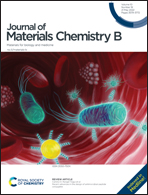Robust, anti-biofouling 2D nanogel films from poly(N-vinyl caprolactam-co-vinylimidazole) polymers†
Abstract
In analogy with adsorbed protein films, we have fabricated a family of 2D nanofilms composed of poly(N-vinyl caprolactam-co-vinylimidazole) (PNVCL) nanogels. NVCL was copolymerized with 1-vinylimidazole (VIM), and then cross-linked with α,ω-dibromoalkanes with 2 to 8 carbons via quaternization to form the nanogels. The swelling ratio of the gels was precisely controlled by regulating the inter-chain spacing of the polymers at the level of the carbon atom chain length of the cross-linker. The short-chain alkanes used are relatively rigid and their dimensions provide an accurate estimate of the chain spacing in the nanogels. It was shown that small differences in the carbon atom number of the cross-linking agent led to significant differences in the mechanical properties of the nanogels, in particular in the softness, deformability, and contact area (in film form), all of which increased with increasing carbon number. Films of the softer gels not only showed good adhesion to a number of substrates, but were also mechanically robust. In addition, the films showed excellent light transmission and nontoxicity to L929 cells. Nanogels of intermediate softness were shown to inhibit the adhesion of bacteria and human umbilical vein smooth muscle cells (HUVSMCs), and to be resistant to the adsorption of the plasma protein fibrinogen, indicating strong anti-biofouling properties. Gels that were either too stiff or too soft showed somewhat weaker anti-fouling activity in terms both of HUVSMCs adhesion and protein adsorption.



 Please wait while we load your content...
Please wait while we load your content...